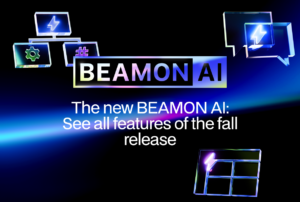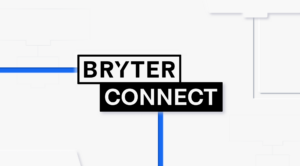We spoke with Sophie Wilson, ELSA Germany President (2020–2021), and Johannes Semrau, Director for Partnership Development at ELSA Germany, about how they improved internal processes with no-code to enable the transfer of legal knowledge to each new generation of students.
Bringing all local groups together
As ELSA Germany is a student organization, they hold elections every year, both across the 44 groups and at the level of ELSA Germany. The interactive FAQ system also helps onboard each coming generation of law students, which Johannes finds helpful in administering knowledge across the organization.
“We have a huge problem with passing down knowledge to the next group each year. Nobody can afford to read long papers, slides, and manuals regarding the existing rules. We wanted to build a tool for our local group to simplify some of the processes we have internally regarding finances and external contacts,” explained Johannes.
Choosing BRYTER
Johannes walked us through the journey of how ELSA Germany decided to turn their processes into apps with BRYTER.
“Initially, we got in touch with BRYTER one and a half years ago for a different project and a different student organization. We did an international moot court with the Council of Europe and one of the talks there was about human rights and automation in the legal field.”
“Coincidentally, BRYTER Head of Solutions Engineering, Johannes Maurer, gave a talk there, alongside Dr Cord Brügmann from the European Lawyers in Lesvos. So, we got in touch with them to learn how BRYTER could be implemented. And the main selling point for us was the Lego-like nature of building blocks that BRYTER brings.”
“We were also looking for a solution that doesn’t require extensive technical knowledge, as we wanted new law students coming each year to be able to handle the process and make changes without extensive coding skills or other technical knowledge.”
Building with BRYTER
“I used the opportunity [of working with BRYTER] to build an interactive FAQ. It is a simple system where the local groups can send our president, Sophie, documents, such as Excel sheets, with all the necessary information she needs regarding our coordination and the coordination with the level above—because we have not only the German group and 44 local groups, but all 43 countries participating in ELSA at the national level. So, with 400 groups across Europe, there is quite a demand for organization.”
“The tool we built with BRYTER is easy-to-use: it is a lightweight process for the user. Anyone who wants to talk to a partner can fill out an Excel sheet and will also have all the information in one place. And to that we’ve added an integration with Microsoft, to enable email automation that ensures an automatic response after 28 days.”
“We have built an interactive FAQ bot for local groups. We have a central system in Germany, which helps organize the 44 local university groups, regarding contacting partners and external contacts. And the tool we built also help us deliver information to everyone involved—for instance, discovering which law firm is involved in a partner project—and coordinate communication smoothly between all of these groups.”

Getting advice on the next step
As ELSA Germany president, Sophie also works to enforce the rules and coordinate all efforts by the local groups.
“The biggest challenge was definitely knowledge management. The regulations just seemed too complex, especially for people who were new to the association and couldn’t really figure out why we have the regulations, why it’s so complex.”
“And so many people didn’t follow their obligations just because they didn’t know they existed or because they misinterpreted the text. So, a lot of people didn’t really understand what they had to do, and especially whom they have to contact.”
“And that’s one of the biggest things that the FAQ now solves—because the tool always leaves you with a final result—and that’s who to contact next and what the next step should be.”
Using the most up-to-date document version
“Besides that, the FAQ tool also helps everyone have access to the most up-to-date document versions that are in line with our regulations. We used to store and share files through Google Drive internally, within the network. And there were a few old versions of documents that were flying around,” explained Sophie.
“Sometimes, a local group would use a document that they have maybe made a copy of years ago and then saved it. But this document has been updated five times since that point. So, they were using a document that didn’t comply with the current regulations anymore, which is why now we have the most current version of the Excel sheet uploaded before a contact approval request can be sent. This basically solves all of those big problems that we’ve mentioned.”
“BRYTER allows us to do both the standardization and automation of the processes.”
“In addition to standardizing the processes, BRYTER helps us automate some of them. For instance, every email looks the same, which helps us to filter through them via Google mail and set automated email reminders and connect these parts of the process with other tools we use.”
“The FAQ tool we built with BRYTER, which is like a flowchart, lets you not only save every contact within it and store information in a single place, but also always start the process. BRYTER helps forge clear paths ahead for local offices – it works as a single point that connects all other dots in the process.”

Alternative to automation: back to square one
Given the nature of her role as ELSA Germany President, Sophie oversees a large number of organizations in their day-to-day and strategic work. But the lack of a centralized system led to numerous operational inefficiencies—something that automation helped remove.
“Before we had a tool in place, I think I easily spent between five to ten hours just answering questions, which included responding to emails, letting people know that they sent the wrong document and that they had to send that again.”
“I’m pretty sure I’ve spent around two weeks of the year I’ve been in office just dealing with regulation and people not understanding it. Since we’ve adopted the tool, I haven’t really gotten any questions or any wrong documents anymore.”
“Before our last national council meeting where we introduced the tool, one of the groups said that if we don’t find an easier way to answer questions about regulations and correct documents, we shouldn’t be doing it. So, I think that would be one alternative to not having built our interactive FAQ tool.”
“I think we would have to continue relying on what we had before – Q&A documents, as different types of document automation didn’t work. So, the only thing we could have done was to make it harder and more work, and basically pull it apart. So instead of an Excel sheet with 50 contacts you can request, you’d basically have it broken down, but on the other hand you’d have to send an email every single time you want to reach someone and then I’d have to tell them whom to contact.”
“The only thing we could have done differently, other than automate the process with BRYTER, would be to completely rethink the regulation again.”
Looking ahead with BRYTER
Now that the internal coordination between member student organizations is improved, Johannes spoke of the next steps in streamlining ELSA Germany’s operations.
“We have such a big organization, we have an internal grant system, and we have a grant system with our alumni organization and the international organization. So our next project is to connect everything into one place—again, with an interactive flow chart and the straight up process, where you can ask questions regarding your project or the grant request, or where you can get help or find a speaker—and we’re also looking to have some automation through emails and reminders, so that our treasurer can have everything in order.”
“Hopefully, we will cut the time needed for responding to questions and getting back with information within groups. We ultimately hope to defer a rise in workloads, which is our biggest problem. Most of the local groups lack knowledge about which grants to apply for, whether at an international level or alumni, so we want to have this all smoothly connected.”
If you are a not-for-profit organization and would like access to BRYTER no-code platform, apply to BRYTER open, our tech for good program.











